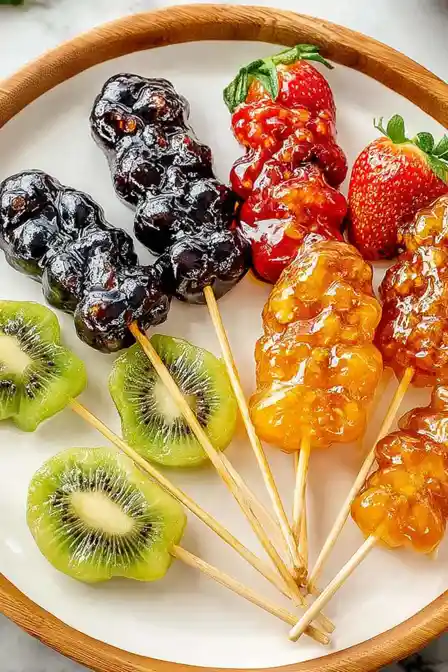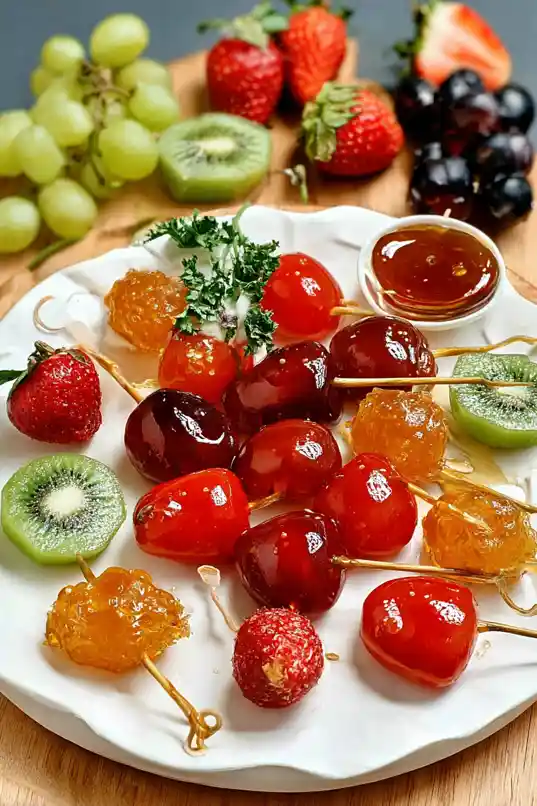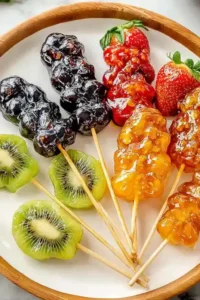
let’s connect in pinterest
Tanghulu Recipe Story and Basics
A Sweet Memory of Tanghulu
The first time I tried a tanghulu recipe at home, it was a hilarious mess—sticky counters, syrup that wouldn’t harden, and sugar that turned chewy instead of crisp. But that’s part of the fun. A tanghulu recipe isn’t about perfection; it’s about enjoying the process and learning how to master that iconic candy shell. Growing up, I loved candy apples, but tanghulu changed everything for me. Its thin, glass-like coating cracks with every bite, letting the fruit’s natural flavor shine. Unlike heavy caramel, a proper tanghulu recipe delivers that perfect mix of crunch and freshness that keeps you coming back.
table of contents
What You’ll Need for Tanghulu
The beauty of any tanghulu recipe lies in its simplicity. With just three ingredients—fruit, sugar, and water—you can create a glossy, crunchy treat that feels like magic. A great tanghulu recipe usually starts with grapes or strawberries, but tart fruits like citrus or blueberries work just as well to balance the sweetness. The key is heating sugar and water to 300°F, the hard crack stage, where syrup turns into a crisp shell. Once dipped and cooled in an ice bath, the fruit gets that iconic shine and crunch. After you’ve mastered the basic tanghulu recipe, the flavor combinations are endless.
How to Make Tanghulu at Home
Quick Method for Tanghulu
Can a tanghulu recipe really take just five minutes? It can—if your prep work is done. When the fruit is already washed, dried, and skewered, a small batch of tanghulu comes together in about five to seven minutes. The key to any fast tanghulu recipe is heating sugar and water in a 2:1 ratio without stirring until it hits the hard crack stage at 300°F. Test a drop in ice water; if it snaps, you’re ready to dip. Work quickly to swirl the fruit and cool it in ice water for that signature glassy shell. In any tanghulu recipe, timing is everything.
rape Tanghulu Variation
Grapes are one of the best fruits to use in any tanghulu recipe. Their crisp texture and natural tartness balance the sweet sugar shell, creating that perfect snap followed by a juicy burst. For a foolproof grape tanghulu recipe, start with firm, seedless grapes—red or green both work well. Skewer three to four per stick and make sure they’re bone dry before dipping into the hot syrup. Moisture will ruin the glossy coating. I still remember my first bite—it snapped like sesame brittle but with a fresher pop. A grape tanghulu recipe is perfect for parties or vibrant fruit boards.
How to Make Tanghulu at Home
Quick Method for Tanghulu
Wondering if you can make tanghulu in five minutes? You can—if your fruit is prepped. When grapes or strawberries are washed, dried, and skewered ahead of time, tanghulu takes just five to seven minutes. Heat sugar and water in a 2:1 ratio without stirring until it hits 300°F. Test a drop in ice water—if it snaps, it’s ready. Dip and swirl your skewers fast, then set them in ice water. Timing is everything in tanghulu making. Once the syrup cools, you lose that signature crunch and shine. So prep ahead and work quickly for perfect homemade tanghulu.
Grape Tanghulu Variation
Grapes make some of the most satisfying tanghulu skewers. Their natural tartness cuts through the sweetness, and their juicy pop pairs beautifully with the thin sugar shell. To make grape tanghulu, choose firm seedless grapes, preferably red or green for contrast. Skewer three to four grapes per stick and follow the same dipping process. The key is ensuring the grapes are bone-dry before dipping, or the sugar won’t adhere. Many street vendors in China favor grapes because their shape holds the candy coating evenly. Serve these as a fun party snack or even as part of a dessert board alongside other fruits like strawberries and mandarins.
When I first tried grape tanghulu, it reminded me of the crunchy texture in sesame brittle but with a fresher burst inside. It’s one of those treats that kids love, yet adults can’t resist either.
Serving, Storage, and Pairing Ideas
Best Way to Serve Tanghulu
Tanghulu shines when served fresh. The sugar shell loses its crispness if left out for too long, so plan to make and serve it right before eating. For a fun presentation, place the skewers upright in a glass or jar, almost like a bouquet of candied fruit. This keeps the coating from sticking together and adds a playful touch to the table. Tanghulu also makes a striking party treat, especially when you mix colors—red strawberries, green grapes, and golden mandarins create a rainbow effect. If you want to elevate dessert time, pair tanghulu with warm green tea or a light jasmine tea to balance the sweetness.
Storage and Creative Pairings
Tanghulu doesn’t store well overnight because the fruit’s moisture softens the candy shell. If you need to keep it for a few hours, store skewers in a cool, dry spot—not the fridge, where humidity melts the sugar. For variety, you can pair tanghulu with other Asian sweets. A platter with tanghulu skewers next to mango sticky rice or ube pancakes creates a dessert spread that’s both colorful and irresistible. Kids love them as after-school snacks, while adults often find them a nostalgic nod to childhood street foods.
I’ve also tried serving tanghulu alongside ice cream for a contrast of hot and cold textures. Imagine biting into a crunchy candied grape right before a spoonful of creamy vanilla. It’s a simple pairing that transforms into a memorable dessert experience.
What are the ingredients to tanghulu?
You only need three basics: fresh fruit, granulated sugar, and water. Traditionally hawthorn berries are used, but strawberries and grapes are now the most popular.
How to make tanghulu in 5 minutes?
If your fruit is prepped and dried, you can heat sugar and water to 300°F, dip the skewered fruit, and set it in an ice bath. Small batches take just about five to seven minutes.
How to make a grape tanghulu?
Choose firm, seedless grapes, skewer three to four per stick, dip in the hot syrup, then chill in ice water. Their tartness makes them one of the best fruits for tanghulu.
Conclusion
This tanghulu recipe brings the classic Chinese candied fruit snack right to your kitchen. Tanghulu is known for its shiny, crackly sugar shell wrapped around juicy fruit like grapes, strawberries, or citrus. With just sugar, water, and fresh fruit, you can make this irresistible treat at home. The secret to a successful tanghulu recipe is using dry fruit and dipping it quickly once the sugar reaches the right temperature. In just minutes, you’ll have beautiful, crunchy skewers that sparkle and snap with every bite. Try this easy tanghulu recipe once, and you’ll see why it’s a favorite Chinese dessert around the world.
for more recipes follow this post

Tanghulu (Chinese Candied Fruit)
Ingredients
Equipment
Method
- Wash and dry fruit completely. Skewer 2–4 pieces per stick.
- Combine sugar and water in a saucepan (2:1 ratio). Heat without stirring until amber and 300°F.
- Test syrup by dropping into ice water. If it cracks, it’s ready.
- Dip skewered fruit into syrup, swirl to coat evenly, then dip into ice water to harden.
- Serve immediately for best crunch.

